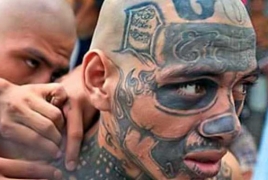 World’s most dangerous gangs. Mara SalvatruchaFrom New York to Alaska The Mara Salvatrucha, or MS13, is believed to be the most notorious street gang in the Western Hemisphere. While it has its origins in the poor, refugee-laden neighborhoods of 1980s Los Angeles, the gang’s reach now extends from Central American nations like El Salvador and through Mexico, the United States, and Canada, with an estimated 60,000 – 80,000 members worldwide. PanARMENIAN.Net - As a result of the civil wars wracking El Salvador, Guatemala, and Nicaragua, refugees flooded northward. Many of them wound up in Los Angeles, living among the mostly Mexican barrios of East Los Angeles. While the Mexican gangs reined in the local underworld, the war-hardened immigrants quickly organized themselves into competing groups, the strongest of which was called the Mara Salvatrucha. Mara: Salvadorian Spanish for “group” or “clique”. Salvatrucha: there is debate over the origin and meaning, the term refers to the founding members’ roots in El Salvador’s civil war, but is commonly known to mean “street smart”. 13: when the Mara Salvatrucha allied themselves with the Mexican Mafia, they adopted “13” as part of their name out of respect, because “M” is the thirteenth letter of the alphabet. They rob, extort and bully their way into neighborhoods and have gradually turned to transnational crimes such as human smuggling and drug trafficking. Their activities have helped make the Northern Triangle - Guatemala, El Salvador, and Honduras - the most violent place in the world that is not at war. By the end of the 1990s, the United States tried to tackle what they were starting to recognize was a significant criminal threat. Partly as a way to deal with the MS13, and partly as a product of the get-tough immigration push toward the end of the Clinton presidency, the government began a program of deportation of foreign-born residents convicted of a wide range of crimes. This enhanced deportation policy, in turn, vastly increased the number of gang members being sent home to El Salvador, Honduras, Guatemala, and elsewhere. According to one estimate, 20,000 criminals returned to Central American between 2000 and 2004. That trend continues. In July 2011, members of the MS13 attended a meeting organized in California by a criminal known as "Bad Boy." In October 2012, the U.S. Department of the Treasury labeled the group a "transnational criminal organization," the first such designation for a U.S. street gang. MS13’s principal activities vary a great deal from one region to another, InSight Crime says. In Central America, where the gang’s reach and size (relative to overall proportions) is largest, MS13’s operations are more diversified. This includes extortion, kidnapping and controlling the neighborhood illegal drug market. Their crimes, such as extorting the bus companies, are arguably more disruptive on a daily basis to more people than any other criminal activity in the region. In the U.S., in contrast, the gang operates much more like an average street gang, with an emphasis on local drug sales and “protecting” urban turf. According to the 2009 National Gang Threat Assessment, "The gang is estimated to have 30,000 to 50,000 members and associate members worldwide, 8,000 to 10,000 of whom reside in the United States. The latest numbers vary, but the U.S. Southern Command says there are as many as 70,000 gang members in the Northern Triangle. There are MS 13 members in at least 42 states – from New York to Alaska. Many Mara Salvatrucha members cover themselves in tattoos. Common markings include "MS", "Salvatrucha", the "Devil Horns", the name of their clique, and other symbols. However, it was presumed that the gang was moving away from the tattoos in an attempt to commit crimes without being noticed. InSight Crime says that the Mara Salvatrucha and two factions of El Salvador’s Barrio 18 gang - Sureños and Revolucionarios – met in October 2016 and agreed to join forces to carry out strategic assassinations against public officials in a "stepped-up war against the system." On paper, the MS13 has a hierarchy, a language, and a code of conduct. In reality, the gang is loosely organized, with cells across Central America, Mexico, and the United States, but without any single recognized leader. The leaders are known as “palabreros,” loosely translated as “those who have the word.” These leaders control what are known as “cliques,” the cells that operate in specific territories. These cliques have their own leaders and hierarchies. Most cliques have a “primera palabra” and “segunda palabra,” in reference to first and second-in-command. Lusine Mkrtumova / PanARMENIAN.Net How collection of horned creatures turned into museum New York’s first female crime boss World’s largest boneyard An Italian photojournalist’s journey through the pandemic Quarantine in metropoles Town without newborns and dead Nine months in the Pacific |